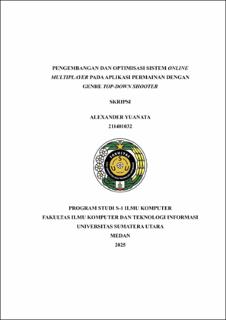| dc.contributor.advisor | Tarigan, Jos Timanta | |
| dc.contributor.advisor | Handrizal | |
| dc.contributor.author | Yuanata, Alexander | |
| dc.date.accessioned | 2025-06-18T09:19:13Z | |
| dc.date.available | 2025-06-18T09:19:13Z | |
| dc.date.issued | 2025 | |
| dc.identifier.uri | https://repositori.usu.ac.id/handle/123456789/104429 | |
| dc.description.abstract | The video game industry is thriving and rapidly expanding in this day and age, especially the mobile games industry. However, a video game must compete with many applications vying for user’s interests. This research aims to implement an effective cooperative multiplayer system’s architecture from the front end to the back end. Implementation of this system aims to increase the game’s competitiveness and document the whole process of developing the mobile game’s multiplayer features. This research implements the feature on the game app “Edurobots” with the primary method of research being literature studies and official Unity documentations. Development of the game used Unity Engine and the Unity Netcode for GameObjects framework, while WebSocket and NodeJS technologies were used to develop the lobby server. The multiplayer feature uses the state synchronization protocol with latency exposure, latency concealment, and dead reckoning techniques to compensate for the negative effect of latency on user experience. Hosting is done on the Google Cloud Platform environment with the Compute Engine service to run game servers and Cloud Monitoring to measure the server’s metrics. Testing is done through metric measurements and usability testing to evaluate the effectivity of the system and user experience. Metric measurements uses two servers (e2-micro and e2-highcpu-2) and measures the latency of clients, CPU/RAM usage, as well as network bandwidth. Usability testing gathers evaluation from users through questionnaires after testing sessions. Metric evaluation reveals that the e2-micro server can handle 4 clients with an average latency of 90,74 ms and a jitter of 17,96 ms which is considered good. CPU usage and server performance is found to impact client latency drastically. If CPU usage exceeds the capacity of the server, then processing time increases which increases client latency. The number of clients do not affect latency significantly, but increases outgoing network bandwidth. The result of the usability testing questionnaire is an average rating of 4.67 out of a scale of 5 and an average score of 4.73 for the effectivity of multiplayer features in increasing player retention of Edurobots. | en_US |
| dc.language.iso | id | en_US |
| dc.publisher | Universitas Sumatera Utara | en_US |
| dc.subject | Multiplayer Game Development | en_US |
| dc.subject | Client-Server Architecture | en_US |
| dc.subject | Unity Netcode for GameObjects | en_US |
| dc.subject | Latency Compensation | en_US |
| dc.title | Pengembangan dan Optimisasi Sistem Online Multiplayer pada Aplikasi Permainan dengan Genre Top-Down Shooter | en_US |
| dc.title.alternative | Development and Optimization of an Online Multiplayer System on a Top-Down Shooter Video Game | en_US |
| dc.type | Thesis | en_US |
| dc.identifier.nim | NIM211401032 | |
| dc.identifier.nidn | NIDN0126018502 | |
| dc.identifier.nidn | NIDN0113067703 | |
| dc.identifier.kodeprodi | KODEPRODI55201#Ilmu Komputer | |
| dc.description.pages | 116 Pages | en_US |
| dc.description.type | Skripsi Sarjana | en_US |
| dc.subject.sdgs | SDGs 9. Industry Innovation And Infrastructure | en_US |


